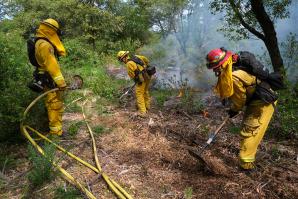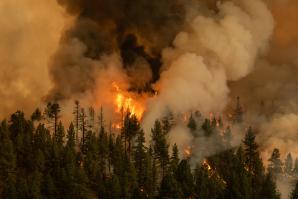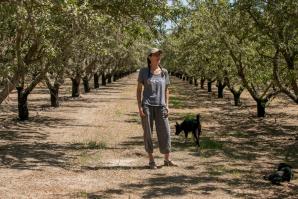If there’s one thing people in the West know how to fight over, it’s water. California was built on scarcity, whether it be gold or silver, land or water. In the mid-1800s, when European Americans arrived to the land where Indigenous people had lived for at least 10,000 years, they wasted no time staking their claims.
A big head-scratcher for those early colonizers was how to get water to sustain burgeoning towns. California’s hydrology didn’t match where people wanted to live. To accommodate growth, most of the state’s largest reservoirs were built between the 1920s and 1980, and in the ensuing decades, people have been arguing over whether we need even more dams.
In the 1970s, battles brewed that directly affected the Capital Region’s water supply, like when East Bay MUD wanted to divert water off the American River. In the 1980s and ’90s, the Capital Region’s population was growing, and in dry years, the river was already oversubscribed, according to reports. The region’s water table — between the soil and groundwater — had dropped in some places by 90 feet, causing parts of the groundwater basin to become contaminated. Competing interests abounded. Just the threat of lawsuits stopped projects dead in their tracks.
“In those days, there was a lot of litigation around water,” says Jim Ray, referring to the period of the 1970s to the 1990s. Ray is president of MacKay & Somps Civil Engineers in Roseville, and a participant of the Water Forum, an agreement that guides greater Sacramento regional water management. The agreement, he says, came out of all this conflict.
The 30-year plan represents the interests of signatories from 40 organizations in Sacramento, El Dorado and Placer counties to provide a safe, reliable water supply, and safeguard the various values of the lower American River. The Water Forum is a nonprofit organization that oversees the agreement, funded by member utilities and a small water connection fee they charge customers. “Our mission is to keep peace on the river and keep peace in the region,” says Executive Director Jessica Law.
The agreement took seven tedious years with a skilled negotiator at the helm to finalize before the 40 organizations signed on in 2000. “The Sacramento Water Forum has been identified as one of these success stories that really adopted this collaborative model and made it work,” says Jennifer Harder, co-director of the Water & Environmental Law concentration at McGeorge School of Law in Sacramento.
Now stakeholders are at it again, in the early stages of negotiating Water Forum 2.0, which goes into effect in 2030. Negotiating an agreement that took seven years to do the first time around is, Law says, “definitely a tall order.”
Keeping the peace
By quickly staking their claims, the Gold Rush miners and industries in the 1840s and ‘50s employed the principle of “first in time, first in right.” Whoever asserted a claim over surface water first, got it. This became the legal doctrine of prior appropriation, tempered with the requirement that water must be put to beneficial use such as farming, industry, fishing or drinking. There are senior appropriators and junior appropriators — the latter must curtail their water use first in dry years. Farmers know quite a bit about dealing with this dilemma. Cities do too.
No one owns water in California. Only permits, licenses and registrations grant someone or some entity the right to beneficially use reasonable amounts of water. But anyone who has a pre-1914 appropriative water right doesn’t need a permit if water use has stayed the same. (The law that created the permitting system for surface water was adopted in 1913, but the permitting requirement took effect in 1914.)
California is also one of only a few Western states to have riparian rights, which grant landowners the right to use the natural flow of water on their land that touches a lake, river, stream or creek. But in drier years that right may not mean very much at all.
One can see how collaboration around water hasn’t always been easy. In 1993, the Sacramento City-County Office of Metropolitan Water Planning first convened the Water Forum. Placer and El Dorado counties joined in the meetings a couple years later. These stakeholders and their history of water conflicts led them to conduct their meetings as a formal mediation process, which focused on their interests rather than demands.
“We began on an interest-based approach to negotiating an agreement, meaning everybody expressed what they felt they needed, but learned to understand whether it was an environmental need, public need or water purveyor need, you have to consider it and we had to find a balance to that,” says Ray, of the forum’s business caucus. Other members include representatives from North State Building Industry Association, Green Acres Nursery & Supply, Sacramento Association of Realtors and Sacramento Metropolitan Chamber of Commerce.
The environmental caucus includes the Environmental Council of Sacramento, Friends of the River, Save the American River Association and others; the public caucus has organizations such as the Sacramento Area Flood Control Agency; Sacramento Municipal Utility District and Sacramento Area Council of Governments; and the water caucus mainly comprises water purveyors.
‘A level of certainty’
The region’s surface water originates in the Sierra Nevada’s snowpack, then travels down via the upper American River into the Sacramento Valley to feed the Folsom Reservoir. “Folsom is a reservoir that is relatively small in the scale of things. It’s under a million acre-feet,” Ray says. Shasta Reservoir, for comparison, can hold 4.5 million acre-feet of water. “(Folsom Reservoir) has many purposes. It’s a flood control facility. It’s a recreational facility. It’s obviously a water supply facility. It has a role in keeping saltwater intrusion from coming up the delta from the bay, and so it tries to perform multiple functions.”
Some water continues down the lower American River, emptying into the Sacramento-San Joaquin River Delta and flowing into the San Francisco Bay and into the Pacific Ocean; some water goes farther south to other parts of the state. The river is home to many native fish species and has been dramatically altered by human activity ever since the Gold Rush.
Besides its ecological value, a healthy American River affects quality of life and economic development, Ray says. He points to how the American River Parkway has 8 million visitors a year. “When you think about attracting new business, residents that choose to come here and live and support our economy, it’s really an asset to the entire Sacramento region,” he says.
While compromises existed in the original Water Forum agreement, supporters say the benefits outweigh them. “What it did … was provide a level of certainty and a reliable supply that you can count on if you were planning a business expansion that needed water, or in my case, a development project that had to demonstrate there was sufficient water,” Ray says. “The agreement really was successful because, particularly for the business side of the world, it allowed those things to happen and water agencies to move forward on projects that increase their facilities and capabilities.”
Water managers plan for the long shelf life of a project, which can first take a decade to design, develop and construct. Sean Bigley, assistant environmental utilities director for the City of Roseville, agrees the Water Forum supports planning for infrastructure projects. “That all takes time,” he says. “To be able to do that you need a stable footing and I think that the Water Forum, on a longer-term basis, provides that sort of stability for the region.”
The City of Roseville implemented a system that can store surface
water in an aquifer during a wet year and extract the water
during a drought. Sean Bigley, assistant environmental utilities
director, stands beside some of the piping at the city’s Blue
Oaks well site.

Since the first agreement was signed, one major crisis has energized change. The historic drought beginning in 2012 led to the Sustainable Groundwater Management Act of 2014, which Harder, the McGeorge professor, describes as one of “the biggest changes in the last 100 years” when it comes to water law. Groundwater is found beneath the earth’s surface, filling the space in soil pores, rock formations and sand. An aquifer is the porous rock and sediment saturated with water; wells can be drilled into aquifers and water pumped out.
While certain areas had effectively managed groundwater prior to SGMA, Harder says the missing piece was the consideration of sustainability on a basin-wide basis. “What you had was the demarcation of different groundwater managers and groundwater users scattered throughout a basin without any comprehensive obligation to comprehensively understand and manage the basin at that basin-wide scale,” she says.
California didn’t adopt a regulatory system for groundwater early on, instead relying on common law based on court decisions. “That does not make for good management of a natural resource,” Harder says. Water providers long rejected comprehensive management, worrying about the impact to their short-term interests. Then the calculus changed, Harder says. “Individual water users saw in their long-term interests, it actually serves those interests better to manage on a basis-wide scale.”
In 1998, the Sacramento Groundwater Authority formed as a joint-powers authority of 14 water providers and users to collectively manage the groundwater basin in Sacramento County (the southern third of the North American Subbasin). The SGA was regarded as a model for SGMA, and the organization plays an important role in implementing the Water Forum’s groundwater management element.
“We have a strong history of innovating,” Law says of the region. “We have a strong history of being 20 steps or 20 years or 10 years ahead of the curve.”
But now water managers have an especially challenging consideration that’s hard to get ahead of. It’s one already underway and on the forefront of all of their minds.
‘Unprecedented conditions’
Law thinks the phrase weather whiplash is brilliant — an apt way to describe what happens or what a person feels when temperatures go from the 70s one day to snowing the next. It “describes the mental gymnastics that natural resource managers have to do,” Law says. They check the weather, reservoir levels and river flow rates “every single day.”
Climate change has worsened weather whiplash. Historically, the Sierra Nevada mountains act as a natural reservoir, keeping precipitation stored in the form of snow. As temperatures slowly warm, the snow melts and heads down. Climate change alters this timing, as warmer temperatures earlier in the year cause the snow to run off faster and sooner. The precipitation season will be shortened and more will often come in the form of rain rather than snow, reducing the volume that gets stored in the snowpack. Droughts will become more frequent.
Roseville, through a contract with the U.S. Bureau of Reclamation
Central Valley Project, captures surplus water and stores it in
wells, staying there until future dry periods, like peak summer
months during a drought.

“There simply will be less water in the future,” said Clifford Lee, during a recent webinar hosted by the Sacramento-based Planning and Conservation League. Lee is a former deputy attorney general who taught water law at UC Hastings School of Law and is a heavy hitter in the California water world. “My view is to rely now on historical data to determine future flow estimates in a watershed … to embrace what I’m going to call the ‘Waiting for Godot’ fallacy. As you all know from the Samuel Beckett play, Godot never arrives.”
Climate change makes history an unreliable source for understanding the future. “The past is no longer a prologue, to misquote Shakespeare,” Harder says. She and Lee are two of the co-authors of a February 2022 report commissioned by the PCL to make recommendations on updating California water law for the “unprecedented conditions facing 21st century California.” Drought and climate change are featured prominently, including the point that monitoring diversions and use in real time will be critical in how the region continues to manage water under climate change.
Fish like Chinook salmon and steelhead are part of this equation. They need a certain volume of water in the river and not-too-warm temperatures to survive. Dam operators are required to release water specifically to protect downstream fish. The Water Forum has already created about 30 acres of spawning beds for salmon and plans to invest up to $13 million of state and federal funding over the next five years for more habitat enhancement projects.
Efficiency and conservation will also be incorporated in the next agreement, especially as these measures connect to housing development and population growth. Improvements in outdoor irrigation, drought-tolerant plants, and low-flow appliances, toilets and showerheads have already helped reduce the region’s per capita water use. Future innovation in conservation might relate to recycled water supplies and stormwater capture. Ray says the business caucus believes efficiency should be prioritized because it’s permanent: “It isn’t something that we have to change our behavior for, like conservation, when we’re in a crisis.”
In March, Gov. Gavin Newsom’s administration announced an additional $22.5 million to respond to the drought emergency, which includes $8.25 million to increase outreach efforts to educate people on water conservation measures and practices, according to a press release. As of press time, all 58 counties in the state were under a drought emergency declaration.
The entire western United States is experiencing drought. And, as of this March, about half of the whole country was in drought. The megadrought in the American Southwest is the driest two decades since 800 A.D., according to a story in The New York Times — 1,200 years ago is the farthest back scientists can model using tree ring analysis. A climate scientist at UCLA quoted in the story said there would have been a drought regardless of climate change, but human-caused global warming made it much more severe.
Even though the Capital Region had unusually heavy precipitation last October and December, this January and February were starkly dry. Last year was the driest year in California since 1924. “Dire” seems to be the word of choice for water managers throughout the state. Drought also has a significant economic impact. Last year’s drought cost the state $1.7 billion in about 14,600 lost jobs, according to a March report by UC Merced; most of those impacts were felt in agriculture.
“Under climate change, we know our system is going to be a lot flashier. We’re going to have higher highs, we’re going to have lower lows. The drier years are going to be more frequent. When we have wet events, they’re going to come in fast. Having a system that is as adaptable and quickly able to respond to the changing weather and the changing conditions is going to be really critical going forward.”
Jessica Law, Executive director, Water Forum
“Under climate change, we know our system is going to be a lot flashier,” Law says. “We’re going to have higher highs, we’re going to have lower lows. The drier years are going to be more frequent. When we have wet events, they’re going to come in fast. Having a system that is as adaptable and quickly able to respond to the changing weather and the changing conditions is going to be really critical going forward.”
It takes two
In the early 2000s, the City of Roseville considered how to diversify its water portfolio, which had been largely dependent on the Folsom Reservoir, and explored an advanced technology called aquifer storage and recovery. Unlike a traditional groundwater well that only pulls out water, this technology allows for both the extraction and recharge of water. This helps facilitate conjunctive use — the coordinated use of surface water and groundwater.
“We have the opportunity to basically switch from using surface water, which in drought conditions is scarce or there’s not a whole lot in the system, to actually using groundwater,” Bigley says. “The reverse is when we have wet years, or even normal years for that matter, we’re basically using surface water supplies. It provides a lot of flexibility in terms of our system.”
The City of Roseville has an Aquifer Storage and Recovery system
where the city can inject and later extract stored drinking water
from the groundwater basin. (Infographic courtesy of the City of
Roseville)

This January, Roseville used the ASR system after Folsom Reservoir gained lots of water quickly during last December’s heavy rainfalls. Federal water managers oversee the reservoir and decide when to release water for flood control and other considerations out to the Pacific Ocean. Roseville, through a contract with the U.S. Bureau of Reclamation Central Valley Project, captured surplus water and stored it in the ASR wells, staying there until future dry periods, like peak summer months during a drought.
This practice is called banking water, like a savings account. The city has been using this system of replenishment and extraction for more than a decade; in 2019, it replenished the basin with 952 acre-feet of water, which was used in peak summer months during last year’s drought.
“We paved the way in terms of being able to use that technology within the state and also was at the time pretty unique to Northern California as far as the technology,” Bigley says. The city has four operational ASR wells with the goal of adding another six over the course of the next seven years. Two are under construction.
This interchangeability reduces demand for surface water, improves the health of the lower American River and allows for more cold water to stay in the system to benefit fish species.
The Sacramento Groundwater Authority recently announced its plan to build the Sacramento Region Water Bank for an estimated cost of $1.15 million over the next five years (split among agencies in Sacramento, Placer and Sutter counties). The bank is a component of the North American Subbasin Groundwater Sustainability Plan, required under SGMA, which will guide sustainable management of the groundwater basin over the next 20 years, according to a press release for the project.
The plan “marks a new chapter as we work together to sustainably manage the basin with an eye toward adapting our region’s water resources to climate change,” said SGA Executive Director Jim Peifer, in the release. This bank will allow the region to sustainably increase its reliance on groundwater.
“There’s a lot of challenges ahead in terms of what we’re going to see in … water supply and impacts to the environment and … to the climate,” Bigley says. “But I feel like we, as a region, we’re really strong, we work really well together, and I feel very optimistic about our ability to prepare well for those challenges in the future.”
“There’s a lot of challenges ahead in terms of what we’re going to see in terms of water supply and impacts to the environment and impacts to the climate. But I feel like we, as a region, we’re really strong, we work really well together, and I feel very optimistic about our ability to prepare well for those challenges in the future.”
Sean Bigley, Assistant environmental utilities director, City of Roseville
Water work is slow going. It can be extremely complex and easy to end up stalled. The Water Forum, say its supporters, built the governance structure to get to consensus for the greater good. Now they have eight years left to prepare for the next chapter.
“It can feel really slow because it’s a lot of talking,” Law says. “It’s a lot of looking at data and coming to a common perspective. … It takes skill and practice to shift perspective and stand in somebody else’s spot and see things from their worldview. In the society that we’re living in now and things are really fast-paced, I think it can feel a little bit painful sometimes. But it’s worth it. It’s so worth it.”
–
Stay up to date on business in the Capital Region: Subscribe to the Comstock’s newsletter today.
Recommended For You

How Drought Affects the American River’s Salmon
Salmon will struggle this year. It’s up to us to help them.

Beating the Burn
California’s plan to deal with deadly and devastating wildfires — including controlled burns, thinning and a restoration economy — is ambitious; is the state up to the task?
Past approaches to forest fires have been a misinformed regime of fire suppression: extinguishing all flames quickly. Now California’s forests are overgrown tinderboxes-in-waiting; the approach is changing, but there’s a lot of work to do.

Harnessing Psychedelics for Healing
A UC Davis chemist is developing drugs with all the therapeutic effects of psychedelic drugs — without the hallucinogenic trip.

Earth, Wind and the Fire Next Time
Climate change is a factor in California’s rampaging wildfires, but not the only one
Due to human influence, three primary ingredients of wilderness fires are on the rise: the accumulation of biofuels in the forest, rising heat of the planet as a whole, and an ineffective political system of fire management.

Torture Orchard
Can science transform California crops to cope with drought?
The search is on to help California farmers find less-thirsty tree crops. But will the experiments come through in time as droughts intensify?




